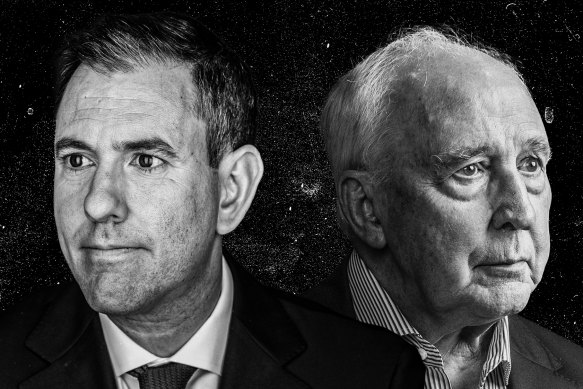This was published 1 year ago
Editorial
Chalmers is often compared to Keating but all three budgets have lacked ambition
In some ways Jim Chalmers’ third budget is a financial statement for our times.
As the population ages, and demand for disability services grows, it invests in Australia’s burgeoning care industries. As the nation confronts an epidemic of gender-based violence, it bolsters support for victims. And as the world moves towards net-zero, the Future Made in Australia package flags tens of billions for new but often-unproven technologies.

Treasurer Jim Chalmers (left) and former treasurer and prime minister Paul Keating.Credit: SMH
The budget includes measures to help women play a bigger role in the economy and, as geostrategic threats grow, allocates a record amount for defence.
But, sadly, it is devoid of reforms needed to ensure these measures can be funded in perpetuity.
Revenue windfalls driven by robust commodity prices, high inflation, a tight labour market and record population growth have recently papered over growing structural budget challenges.
During the two decades before COVID-19, federal spending averaged about 24.5 per cent of Australia’s gross domestic product.
Amid the upheavals of the pandemic emergency, Commonwealth payments surged to a historic high of 31 per cent of GDP and have remained elevated ever since.
The budget papers show that over the four years to 2027-28, spending will average 26.3 per cent. In other words, federal spending has settled at almost 2 percentage points of GDP more each year than what was typical before the pandemic.
So far, huge revenue windfalls have prevented a budget blowout. Analysis by Westpac published last week says that since Chalmers’ first budget, in October 2022, federal revenues had been upgraded by a massive $341 billion over the five years to mid-2027.
But the fiscal sugar-rush will fade.
The days when Australia could rely on windfalls to increase spending without racking up huge deficits were always numbered. They now appear to be running out; the prices of some (although not all) commodity exports are easing, wages growth is moderating, migration and population growth are slowing, economic growth is sluggish, and the labour market is forecast to weaken.
This budget forecasts that the national unemployment rate, now 3.8 per cent, will climb to 4.5 per cent by the middle of next year.
There is voter support for some of the fast-growing areas of budget expenditure such as aged care, the NDIS and defence. But the question remains: how will it be paid for?
After two successive surpluses, the government has opted to run deficits over the next four years. Chalmers said in his budget speech that this is because “pressures on the budget intensify” in coming years.
But further borrowing is not sustainable; the budget shows gross Commonwealth debt is already on track to hit $1 trillion in 2025-26, equivalent to 35 per cent of GDP.
What’s missing from the budget is an ambitious reform agenda to boost productivity and improve our tax system. Barring more lucky budget windfalls, that is the only way the nation will be able to pay for the services voters expect from governments.
Chalmers famously wrote a PhD thesis about Paul Keating before entering politics, and the young treasurer is often portrayed as a Keating-like politician intent on revitalising the Australian economy.
But his three budgets have failed to emulate the reformist zeal of his celebrated Labor predecessor.
It is time for Chalmers to rise to the challenge and outline a reform vision that sets both the Australian economy and the federal budget on a firmer footing.
Cut through the noise of federal politics with news, views and expert analysis. Subscribers can sign up to our weekly Inside Politics newsletter.